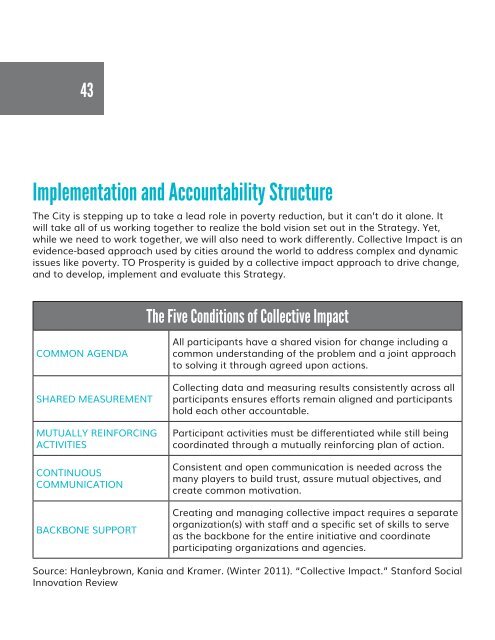TO Prosperity: Toronto Poverty Reduction Strategy
You also want an ePaper? Increase the reach of your titles
YUMPU automatically turns print PDFs into web optimized ePapers that Google loves.
43<br />
Implementation and Accountability Structure<br />
The City is stepping up to take a lead role in poverty reduction, but it can’t do it alone. It<br />
will take all of us working together to realize the bold vision set out in the <strong>Strategy</strong>. Yet,<br />
while we need to work together, we will also need to work differently. Collective Impact is an<br />
evidence-based approach used by cities around the world to address complex and dynamic<br />
issues like poverty. <strong>TO</strong> <strong>Prosperity</strong> is guided by a collective impact approach to drive change,<br />
and to develop, implement and evaluate this <strong>Strategy</strong>.<br />
The Five Conditions of Collective Impact<br />
COMMON AGENDA<br />
SHARED MEASUREMENT<br />
MUTUALLY REINFORCING<br />
ACTIVITIES<br />
CONTINUOUS<br />
COMMUNICATION<br />
BACKBONE SUPPORT<br />
All participants have a shared vision for change including a<br />
common understanding of the problem and a joint approach<br />
to solving it through agreed upon actions.<br />
Collecting data and measuring results consistently across all<br />
participants ensures efforts remain aligned and participants<br />
hold each other accountable.<br />
Participant activities must be differentiated while still being<br />
coordinated through a mutually reinforcing plan of action.<br />
Consistent and open communication is needed across the<br />
many players to build trust, assure mutual objectives, and<br />
create common motivation.<br />
Creating and managing collective impact requires a separate<br />
organization(s) with staff and a specific set of skills to serve<br />
as the backbone for the entire initiative and coordinate<br />
participating organizations and agencies.<br />
Source: Hanleybrown, Kania and Kramer. (Winter 2011). “Collective Impact.” Stanford Social<br />
Innovation Review

















